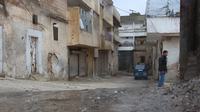Not an average winter in Syria
Not an average winter in north SyriaAfter almost 9 years of war, resilience is at its lowest
The 8th winter of war
People's health, finances, and emotional resources are much worse now after so many years of violence and skyrocketing prices. Now, winter has made them even more vulnerable. Families struggle to buy fuel and warm clothes to cope with low temperatures.
Many who flee are in urgent need of humanitarian support, in particular shelter, food, medicine, household items and assistance to survive the winter.
Recent attacks in Idlib Civilians targeted in the areas they sought refuge
Recent attacks in Idlib Civilians targeted in the areas they sought refuge


Since 1 December 2019, a new wave of attacks has displaced more than 350,000 people who had to flee their homes or places they had relocated to. They have mainly fled southern Idlib, moving further north to escape the hostilities, heading particularly for urban centres.
The areas these displaced people can flee to are shrinking, with civilians finding themselves trapped and targets of new attacks. Ariha, a town hosting many displaced people, was hit by airstrikes on 5 January 2020, resulting in the deaths of at least 11 people, including several children, according to local sources.

Amina
Amina, forever a knitter
“Everything had changed. Six months after arriving back, my husband and I opened a small shop to sell wool. A week later, my husband died in an airstrike along with our neighbour. I lost both: my husband and all our money.”
Amina stopped knitting professionally some time ago, when she began suffering from back pain and asthma.
Ahmed
Ahmed, a life of challenges
However, he adds that there were other reasons his job was not going to last: “My hand was getting weaker and weaker due to a nerve disease that grew worse after all the long working days, especially in cold weather. I had to quit sewing. The doctor said I had to stop working if I wanted to still be able to use my hand.”
Najah's determination
The whole family left their home in rural Damascus in 2012 and have not been able to return. Every few months, they have had to move to a different house. Losing the family breadwinners—her husband and eldest son—was and still is the most difficult challenge for the family.
































 Not an average winter in north Syria
Not an average winter in north Syria
 The 8th winter of war
The 8th winter of war
 Cold outdoors and indoors
Cold outdoors and indoors
 Recent attacks in Idlib
Recent attacks in Idlib
 3 winter stories
3 winter stories
 Amina, forever a knitter
Amina, forever a knitter
 Amina's house
Amina's house
 Amina, forever a knitter
Amina, forever a knitter
 Ahmed, a life of challenges
Ahmed, a life of challenges
 Ahmed, a life of challenges
Ahmed, a life of challenges
 Najah's determination
Najah's determination
 Najah's determination
Najah's determination
 Assistance
Assistance
